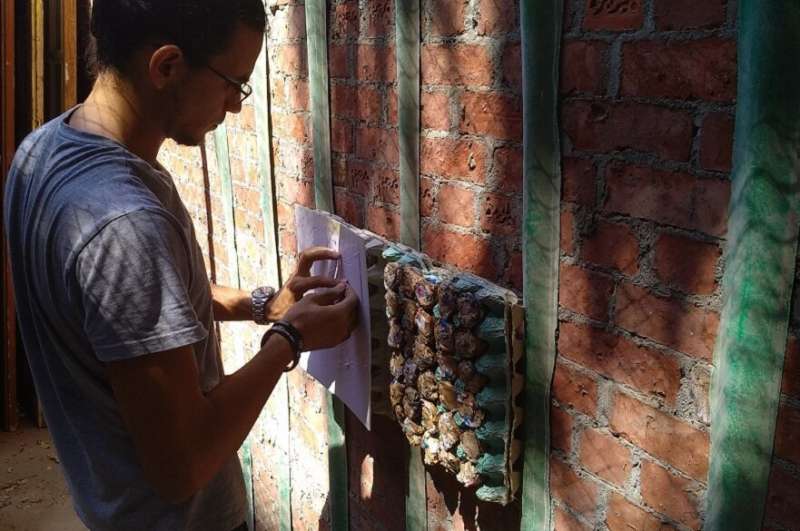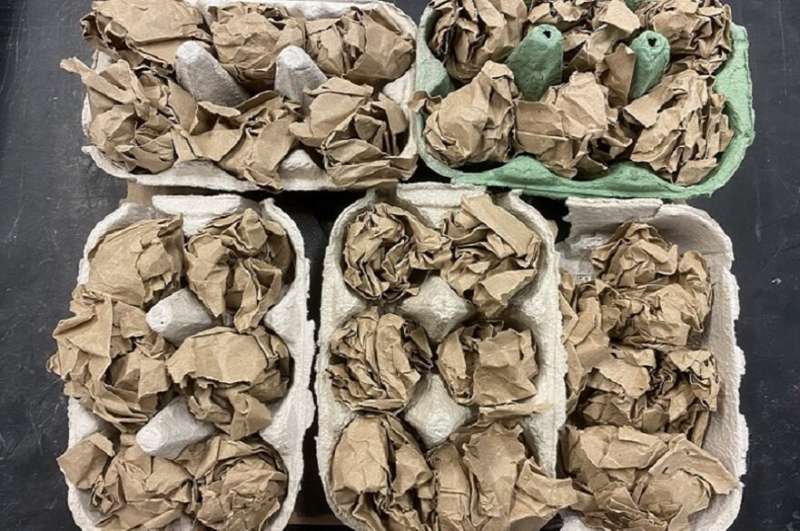
Waste materials, including egg trays and plastic takeaway lunch box lids, can be used to insulate homes in hot arid regions to considerably improve their energy efficiency, a new study shows.
Waste materials, including egg trays and plastic takeaway lunch box lids, can be used to insulate homes in hot arid regions to considerably improve their energy efficiency, a new study shows.
Research by sustainable architecture and engineering expert Farres Yasser—a Ph.D. candidate at Nottingham Trent University—shows that a composite of egg trays, cardboard, polypropylene plastic lids and Styrofoam can be used to retrofit single brick homes with exterior wall insulation.
A range of tests took place in Cairo, Egypt, where the materials are commonly available for free, with more than 23% of the city’s waste being made up of paper, cardboard and plastic.
The study—which involved practical experiments with the support of local tradespeople –shows a sustainable way to insulate homes in hot arid regions like Egypt, where more than 70% of homes are considered to be insulated poorly.
“Reusing waste to create new products will not only save precious natural resources, but it has the potential to save $1 trillion on new materials within the next decade,” said Mr. Yasser, of the School of Architecture, Design and the Built Environment.
“This study clearly demonstrates the true potential for how commonly discarded materials like egg trays and Styrofoam can be used to transform the way we insulate homes.
“Not only are these materials largely available for free, but by working with local tradespeople and residents, we have demonstrated how a composite insulation can be compressed easily in an environmentally friendly way.”
The materials were collected free of charge from local suppliers, including kiosks and takeaway kitchens, which were otherwise looking to throw them away.

The insulation was made by filling egg trays with papier-mâché to make a thick insulative composite layer, before placing the lids from discarded plastic lunch boxes on one side and discarded Styrofoam on the other.
The materials were then glued together with sand and Adibond 65, a versatile adhesive, and compressed with a considerable weight, using only gravity to compress the materials together.
A two-centimeter eco mortar—made of sand, dirt, Adibond 65 and cement—was applied to the outer shell to allow for plastering and various aesthetic finishes.
Experiments undertaken during summer showed that a single red brick test chamber insulated with the composite was cooler on average by 3°C than the same structure without insulation.
Similarly, during winter, the single brick chamber fitted with the composite provided was up to 3.6°C warmer than the control chamber, between 7am and noon.
Potential energy savings measure between 2000–3500 Kw h per household in the four hottest months of the year, depending on the type of cooling device used.
“Poor building materials, or single-layered red bricks homes, increase the use of heating, ventilation, and air conditioning (HVAC) systems, which produce carbon emissions all year round,” said Mr. Yasser.
“This study shows how waste can take the place of conventional insulation materials which can be bad for the environment, and reveals the possibility of using unsophisticated, low-cost, and locally available methods to build insulation panels.
“These panels require little to no machinery to create and fossil fuel-free methods to collect, compress, and install. They are affordable and unhazardous and could lead to a fundamental reduction of carbon emissions throughout a building’s construction and lifetime.”
Citation:
Study shows how waste can be used to insulate homes in hot regions (2023, January 6)
retrieved 6 January 2023
from https://techxplore.com/news/2023-01-insulate-homes-hot-regions.html
This document is subject to copyright. Apart from any fair dealing for the purpose of private study or research, no
part may be reproduced without the written permission. The content is provided for information purposes only.
Stay connected with us on social media platform for instant update click here to join our Twitter, & Facebook
We are now on Telegram. Click here to join our channel (@TechiUpdate) and stay updated with the latest Technology headlines.
For all the latest Technology News Click Here
For the latest news and updates, follow us on Google News.
